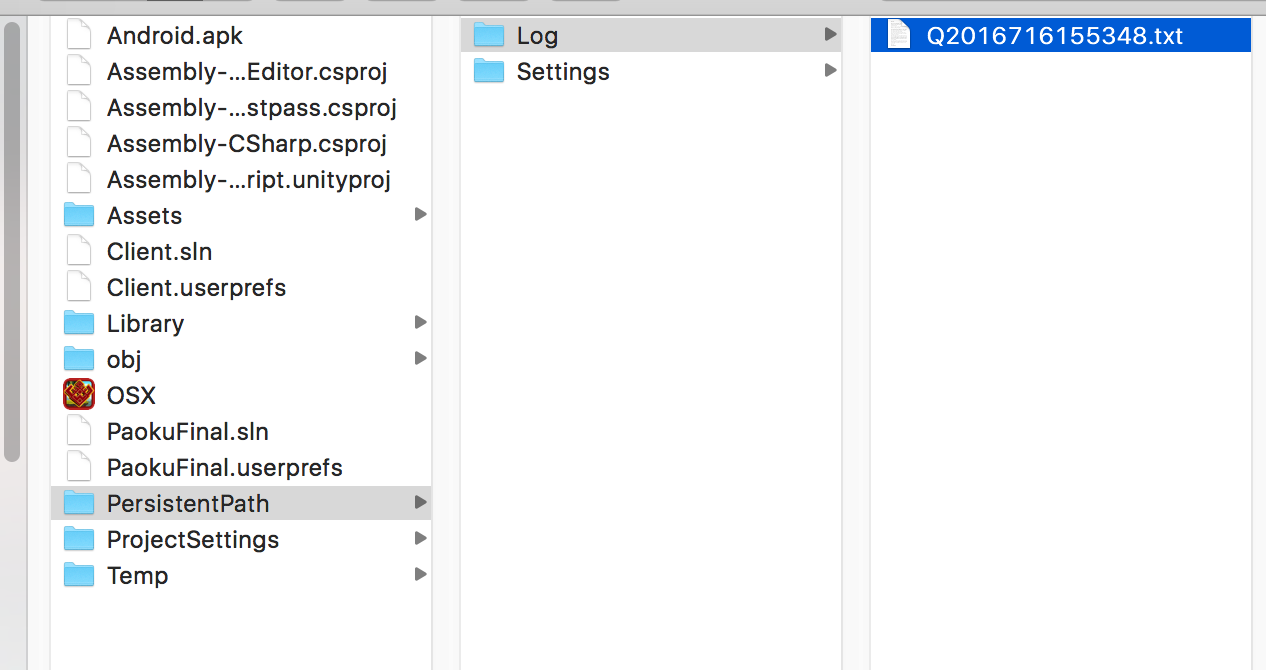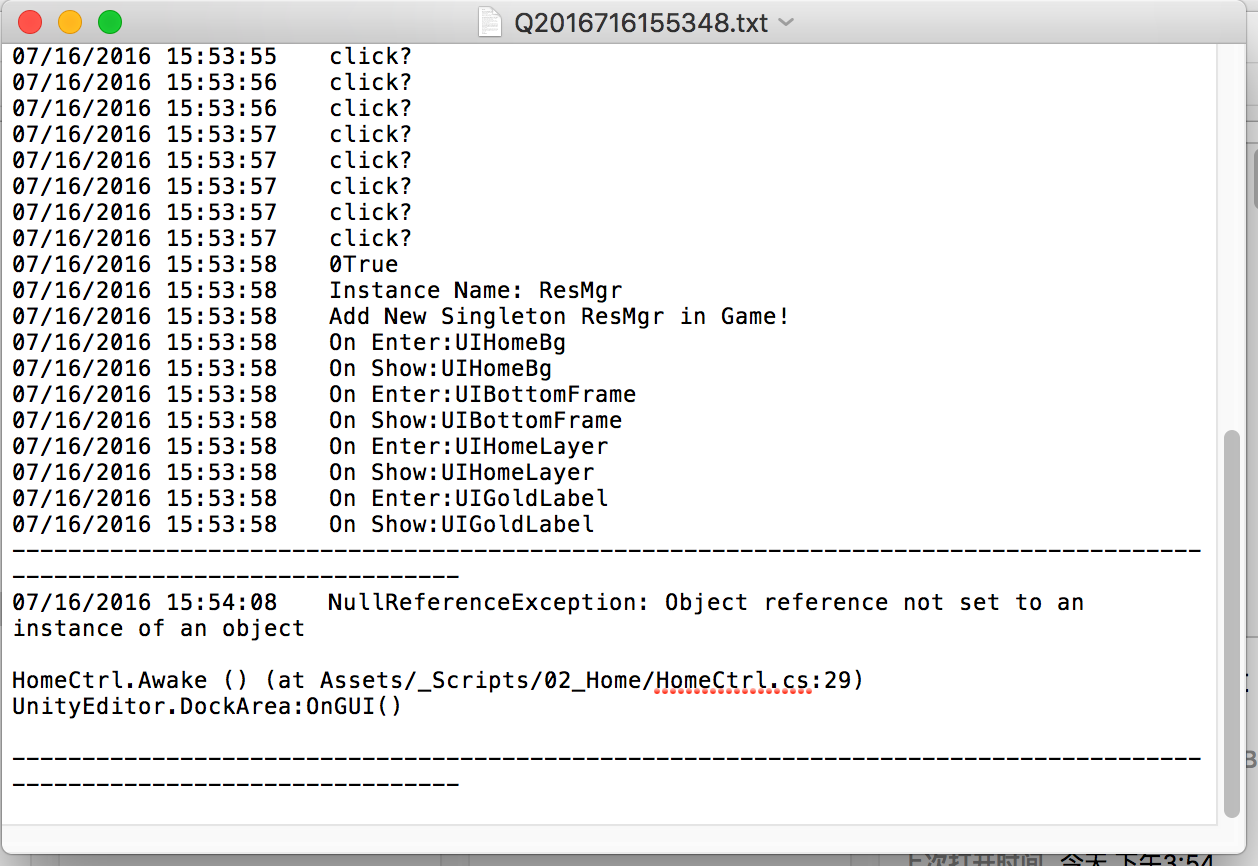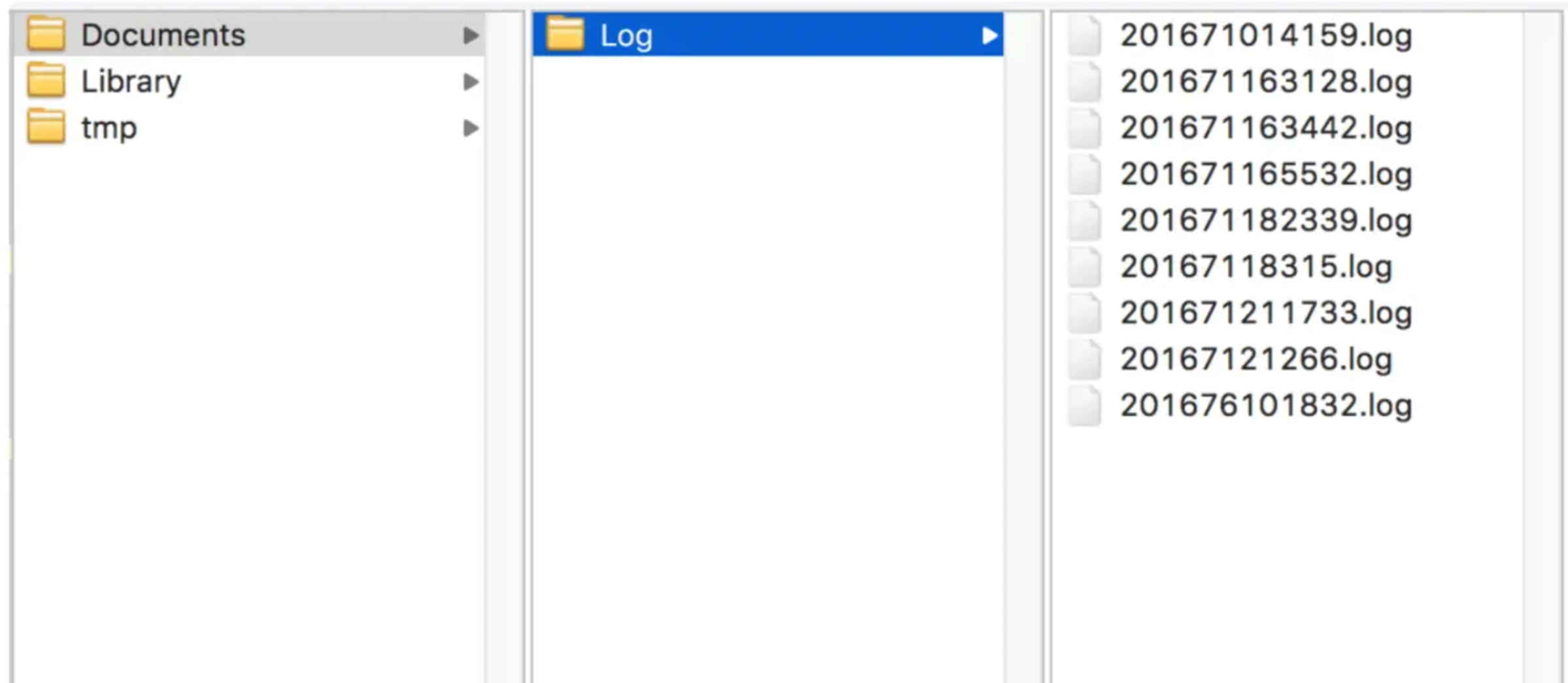## 为毛要实现这个工具?
在我小时候,每当游戏到了测试阶段,交给 QA 测试, QA 测试了一会儿拿着设备过来说游戏闪退了。。。。当我拿到设备后测了好久 Bug 也没有复现,排查了好久也没有头绪,就算接了 Bugly 拿到的也只是闪退的异常信息,或者干脆拿不到。很抓狂,因为这个我是没少加班。所以当时想着解决下这个小小的痛点。。。
## 现在框架中的 QLog:
怎么用呢?在初始化的地方调用这句话就够了。
```cs
QLog.Instance ();
```
其实做成单例也没有必要。。。。
## 日志获取方法:
PC端或者Mac端,日志存放在工程的如下位置:

打开之后是这样的:

最后一条信息是触发了一个空指针异常,堆栈信息一目了然。
如果是iOS端,需要使用类似同步推或者iTools工具获取日志文件,路径是这样的:

Android端的话,类似的方式,但是具体路径没查过,不好意思。。。
## 初版
一开始想做一个保存Debug.Log、Debug.LogWaring、Debug.LogErr信息到本地文件的小工具。上网一查原来有大神实现了,贴上链接:http://www.xuanyusong.com/archives/2477。
其思路是使用 Application.RegisterLocCallback 注册回调,每次使用 Debug.Log 等 API 时候会触发一次回调,在回调中将 Log 信息保存在本地。而且意外的发现,Application.RegisterLogCallback也能接收到异常和错误信息。
所以将这份实现作为QLog的初版用了一段时间,发现存在一个问题,如果游戏发生闪退,好多Log信息没来得及存到本地,因为刷入到本地操作是通过Update完成的,每帧之间的间隔,其实很长。
## 现在的版本:
后来找到了一份实现,思路和初版一样区别是将Update改成线程来刷。Application.RegisterLogCallback 这时候已经弃用了,改成了 Application.logMessageReceived,后来又找到了 Application.logMessageReceivedThreaded。
如果只是使用 Application.logMessageReceived的时候,在真机上如果发生 Error 或者 Exception 时,收不到堆栈信息。但是使用了 Application.logMessageReceivedThreaded 就可以接收到堆栈信息了,不过在处理Log信息的时候要保证线程安全。
说明部分就这些吧,实现起来其实没什么难点,主要就是好好利用 Application.logMessageReceived 和Application.logMessageReceivedThreaded 这两个API就好了。
下面贴上我的框架中的实现,这里要注意一下,这份实现依赖于上篇文章介绍的App类(已经重命名为QApp了)。
接口类ILogOutput:
```cs
using System;
using System.Collections.Generic;
using System.Linq;
using System.Text;
namespace QFramework {
/// <summary>
/// 日志输出接口
/// </summary>
public interface ILogOutput
{
/// <summary>
/// 输出日志数据
/// </summary>
/// <param name="logData">日志数据</param>
void Log(QLog.LogData logData);
/// <summary>
/// 关闭
/// </summary>
void Close();
}
}
```
接口实现类 QFileLogOutput
```cs
using System;
using System.Collections.Generic;
using System.Text;
using System.Threading;
using System.IO;
using UnityEngine;
namespace QFramework {
/// <summary>
/// 文本日志输出
/// </summary>
public class QFileLogOutput : ILogOutput
{
#if UNITY_EDITOR
string mDevicePersistentPath = Application.dataPath + "/../PersistentPath";
#elif UNITY_STANDALONE_WIN
string mDevicePersistentPath = Application.dataPath + "/PersistentPath";
#elif UNITY_STANDALONE_OSX
string mDevicePersistentPath = Application.dataPath + "/PersistentPath";
#else
string mDevicePersistentPath = Application.persistentDataPath;
#endif
static string LogPath = "Log";
private Queue<QLog.LogData> mWritingLogQueue = null;
private Queue<QLog.LogData> mWaitingLogQueue = null;
private object mLogLock = null;
private Thread mFileLogThread = null;
private bool mIsRunning = false;
private StreamWriter mLogWriter = null;
public QFileLogOutput()
{
QApp.Instance().onApplicationQuit += Close;
this.mWritingLogQueue = new Queue<QLog.LogData>();
this.mWaitingLogQueue = new Queue<QLog.LogData>();
this.mLogLock = new object();
System.DateTime now = System.DateTime.Now;
string logName = string.Format("Q{0}{1}{2}{3}{4}{5}",
now.Year, now.Month, now.Day, now.Hour, now.Minute, now.Second);
string logPath = string.Format("{0}/{1}/{2}.txt", mDevicePersistentPath, LogPath, logName);
if (File.Exists(logPath))
File.Delete(logPath);
string logDir = Path.GetDirectoryName(logPath);
if (!Directory.Exists(logDir))
Directory.CreateDirectory(logDir);
this.mLogWriter = new StreamWriter(logPath);
this.mLogWriter.AutoFlush = true;
this.mIsRunning = true;
this.mFileLogThread = new Thread(new ThreadStart(WriteLog));
this.mFileLogThread.Start();
}
void WriteLog()
{
while (this.mIsRunning)
{
if (this.mWritingLogQueue.Count == 0)
{
lock (this.mLogLock)
{
while (this.mWaitingLogQueue.Count == 0)
Monitor.Wait(this.mLogLock);
Queue<QLog.LogData> tmpQueue = this.mWritingLogQueue;
this.mWritingLogQueue = this.mWaitingLogQueue;
this.mWaitingLogQueue = tmpQueue;
}
}
else
{
while (this.mWritingLogQueue.Count > 0)
{
QLog.LogData log = this.mWritingLogQueue.Dequeue();
if (log.Level == QLog.LogLevel.ERROR)
{
this.mLogWriter.WriteLine("---------------------------------------------------------------------------------------------------------------------");
this.mLogWriter.WriteLine(System.DateTime.Now.ToString() + "\t" + log.Log + "\n");
this.mLogWriter.WriteLine(log.Track);
this.mLogWriter.WriteLine("---------------------------------------------------------------------------------------------------------------------");
}
else
{
this.mLogWriter.WriteLine(System.DateTime.Now.ToString() + "\t" + log.Log);
}
}
}
}
}
public void Log(QLog.LogData logData)
{
lock (this.mLogLock)
{
this.mWaitingLogQueue.Enqueue(logData);
Monitor.Pulse(this.mLogLock);
}
}
public void Close()
{
this.mIsRunning = false;
this.mLogWriter.Close();
}
}
}
```
QLog类
```cs
using UnityEngine;
using System.Collections;
using System.Text;
using System.Collections.Generic;
using System.Threading;
namespace QFramework {
/// <summary>
/// 封装日志模块
/// </summary>
public class QLog : QSingleton<QLog>
{
/// <summary>
/// 日志等级,为不同输出配置用
/// </summary>
public enum LogLevel
{
LOG = 0,
WARNING = 1,
ASSERT = 2,
ERROR = 3,
MAX = 4,
}
/// <summary>
/// 日志数据类
/// </summary>
public class LogData
{
public string Log { get; set; }
public string Track { get; set; }
public LogLevel Level { get; set; }
}
/// <summary>
/// OnGUI回调
/// </summary>
public delegate void OnGUICallback();
/// <summary>
/// UI输出日志等级,只要大于等于这个级别的日志,都会输出到屏幕
/// </summary>
public LogLevel uiOutputLogLevel = LogLevel.LOG;
/// <summary>
/// 文本输出日志等级,只要大于等于这个级别的日志,都会输出到文本
/// </summary>
public LogLevel fileOutputLogLevel = LogLevel.MAX;
/// <summary>
/// unity日志和日志输出等级的映射
/// </summary>
private Dictionary<LogType, LogLevel> logTypeLevelDict = null;
/// <summary>
/// OnGUI回调
/// </summary>
public OnGUICallback onGUICallback = null;
/// <summary>
/// 日志输出列表
/// </summary>
private List<ILogOutput> logOutputList = null;
private int mainThreadID = -1;
/// <summary>
/// Unity的Debug.Assert()在发布版本有问题
/// </summary>
/// <param name="condition">条件</param>
/// <param name="info">输出信息</param>
public static void Assert(bool condition, string info)
{
if (condition)
return;
Debug.LogError(info);
}
private QLog()
{
Application.logMessageReceived += LogCallback;
Application.logMessageReceivedThreaded += LogMultiThreadCallback;
this.logTypeLevelDict = new Dictionary<LogType, LogLevel>
{
{ LogType.Log, LogLevel.LOG },
{ LogType.Warning, LogLevel.WARNING },
{ LogType.Assert, LogLevel.ASSERT },
{ LogType.Error, LogLevel.ERROR },
{ LogType.Exception, LogLevel.ERROR },
};
this.uiOutputLogLevel = LogLevel.LOG;
this.fileOutputLogLevel = LogLevel.ERROR;
this.mainThreadID = Thread.CurrentThread.ManagedThreadId;
this.logOutputList = new List<ILogOutput>
{
new QFileLogOutput(),
};
QApp.Instance().onGUI += OnGUI;
QApp.Instance().onDestroy += OnDestroy;
}
void OnGUI()
{
if (this.onGUICallback != null)
this.onGUICallback();
}
void OnDestroy()
{
Application.logMessageReceived -= LogCallback;
Application.logMessageReceivedThreaded -= LogMultiThreadCallback;
}
/// <summary>
/// 日志调用回调,主线程和其他线程都会回调这个函数,在其中根据配置输出日志
/// </summary>
/// <param name="log">日志</param>
/// <param name="track">堆栈追踪</param>
/// <param name="type">日志类型</param>
void LogCallback(string log, string track, LogType type)
{
if (this.mainThreadID == Thread.CurrentThread.ManagedThreadId)
Output(log, track, type);
}
void LogMultiThreadCallback(string log, string track, LogType type)
{
if (this.mainThreadID != Thread.CurrentThread.ManagedThreadId)
Output(log, track, type);
}
void Output(string log, string track, LogType type)
{
LogLevel level = this.logTypeLevelDict[type];
LogData logData = new LogData
{
Log = log,
Track = track,
Level = level,
};
for (int i = 0; i < this.logOutputList.Count; ++i)
this.logOutputList[i].Log(logData);
}
}
}
```
## 欢迎讨论!
转载请注明地址:凉鞋的笔记:[liangxiegame.com](http://liangxiegame.com)
## 更多内容
* QFramework 地址:[https://github.com/liangxiegame/QFramework](https://github.com/liangxiegame/QFramework)
* QQ 交流群:[623597263](http://shang.qq.com/wpa/qunwpa?idkey=706b8eef0fff3fe4be9ce27c8702ad7d8cc1bceabe3b7c0430ec9559b3a9ce66)
* **Unity 进阶小班**:
* 主要训练内容:
* 框架搭建训练(第一年)
* 跟着案例学 Shader(第一年)
* 副业的孵化(第二年、第三年)
* 权益、授课形式等具体详情请查看[《小班产品手册》](https://liangxiegame.com/master/intro):https://liangxiegame.com/master/intro
* 关注公众号:liangxiegame 获取第一时间更新通知及更多的免费内容。

- 正文
- Unity 游戏框架搭建 2017(一)概述
- Unity 游戏框架搭建 2017(二)单例的模板
- Unity 游戏框架搭建 2017(三)MonoBehaviour 单例的模板
- Unity 游戏框架搭建 2017(四)简易有限状态机
- Unity 游戏框架搭建 2017(五)简易消息机制
- Unity 游戏框架搭建 2017 (六) 关于框架的一些好文和一些思考
- Unity 游戏框架搭建 2017 (七) 减少加班利器-QApp类
- Unity 游戏框架搭建 2017 (八) 减少加班利器-QLog
- Unity 游戏框架搭建 2017 (九) 减少加班利器-QConsole
- Unity 游戏框架搭建 2017 (十) QFramework v0.0.2小结
- Unity 游戏框架搭建 2017 (十一) 简易 AssetBundle 打包工具 (一)
- Unity 游戏框架搭建 2017 (十二) 简易 AssetBundle 打包工具 (二)
- Unity 游戏框架搭建 2017 (十三) 无需继承的单例的模板
- Unity 游戏框架搭建 2017 (十四) 优雅的 QSingleton (零) QuickStart
- Unity 游戏框架搭建 2017 (十四) 优雅的 QSingleton (一) Singleton 单例实现
- Unity 游戏框架搭建 2017 (十四) 优雅的 QSingleton (二) MonoSingleton单例实现
- Unity 游戏框架搭建 2017 (十四) 优雅的 QSignleton (三) 通过属性器实现 Singleton
- Unity 游戏框架搭建 2017 (十四) 优雅的 QSingleton (四) 属性器实现 Mono 单例
- Unity 游戏框架搭建 2017 (十四) 优雅的 QSingleton (五) 优雅地进行GameObject命名
- Unity 游戏框架搭建 2017 (十五) 优雅的 QChain (零)
- Unity 游戏框架搭建 2017 (十六) v0.0.3 架构调整
- Unity 游戏框架搭建 2017 (十七) 静态扩展GameObject 实现链式编程
- Unity 游戏框架搭建 2017 (十八) 静态扩展 + 泛型实现 transform 的链式编程
- Unity 游戏框架搭建 2017 (十九) 简易对象池
- Unity 游戏框架搭建 2017 (二十) 安全的对象池
- Unity 游戏框架搭建 2017 (二十一) 使用对象池时的一些细节
- Unity 游戏框架搭建 2017 (二十二) 简易引用计数器
- Unity 游戏框架搭建 2017 (二十三) 重构小工具 Platform
- Unity 游戏框架搭建 2017 (二十四) 小结
